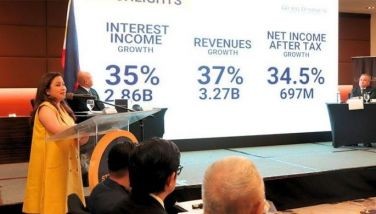The eleventh hour
December 3, 2003 | 12:00am
The country is on the verge of another power crisis reminiscent of the dreadful six to 12 hour daily brownouts in 1989 to 1993 that brought immeasurable damage to our economy.
Mindanao and the Visayas are already experiencing daily power interruptions and it‘s just a matter of time before Luzon is confronted with a similar fate.
Even with a weak economy, power demand continues to grow by six to eight percent yearly. Experts believe that the power shortage in Luzon would occur either in 2006 or 2007, and considering that a five-year lead-time is necessary to finance and build power plants, undeniably, we are already in the eleventh hour.
The National Power Corp. has no capability to build power plants as it is in the bankruptcy stage. In fact, it is expected to lose a whopping P113 billion next year – roughly a third of the consolidated public sector deficit (CPSD). What’s more, in line with the objectives of privatizing the power industry, the Electric Power Industry Reform Act (EPIRA) prohibits government from signing up any new IPP contracts or building new power plants. The exception is when the President certifies to Congress that there’s a power crisis.
With the policy crisis, it is the private distribution utilities and cooperatives that absorb all the beatings.
Take the case of Manila Electric Co. (Meralco). Since the Supreme Court ordered the refund to customers of over P30 billion in charges collected from 1994 to 2003, the firm has been in difficult talks with creditors attempting to refinance its loans.
With the small increase the Energy Regulatory Commission (ERC) gave the power utility last May, its executives have put on a brave face claiming that it will make a P700 million profit this year. But reality tells us otherwise.
Meralco’s rating from international agency Standard and Poors has been reduced to "CC", a notch away from "D" or "default" signifying a warning that debt defaults are imminent. It is a debt rating that prevents it from borrowing. To top it all, banks will not reschedule its loans unless the regulatory environment can assure Meralco’s viability .
Meralco has more than P11 billion in obligations about to fall due before the end of this year. Its return-on-rate base as of 2002 was at 3.9 percent. For this year, it expects to hit 7.9 percent. If it does not get a rate increase, the firm projects an RORB of 7.1 percent next year, lower than the eight percent needed to meet its commitment to creditors.
There are no other options but to cut down on vital expenditures and spending for maintenance and improvements, something detrimental to the efficiency of the power distribution system.
Now that we’re at the 11th hour towards another disaster, the government may have to forget for a while its populist stance and instead arrive at "back to basics" decision that would ensure the viability of our power sector.
Gokongwei-owned Universal Robina Corp. (URC) is slowly but surely making its mark as a regional producer of snacks, candies, biscuits, and wafers.
In fact last year, the company made $84 million overseas. Although local URC sales of $100 million is still bigger, the growth in the regional market is much faster. Not to mention that the potential is so large, especially in China.
JG Summit Holdings president and COO Lance Gokongwei says that in addition to Malaysia, Thailand, Indonesia, and China, URC is entering the Vietnamese market next year for candies. The company is likewise selling chocolates in Indonesia next year, in addition to snacks and candies.
URC has been in Indonesia, selling snacks, candies and chocolates, for the past two years. It has been in China for seven years; nine to 10 years in Thailand where it has been selling snack food, candies, and wafers; and 12 years in Malaysia selling biscuits, snack foods, candies, and wafers. According to Lance, it makes sense to produce candies in Thailand because of the lower price of sugar while Malaysia is an ideal site for making snack foods because of its abundant supply of palm oil. The Philippines, on the one hand, is a low cost producer of biscuits.
When asked whether URC is planning to enter the beverage market, Lance said he would rather stick to producing snack foods, candies, biscuits, and wafers. After all, it will be very difficult to compete with Danding Cojuangco and Lucio Tan in this arena, he says.
From softdrinks to babyfood
Coca-Cola Bottlers Phils. Inc. president Genju Lapez has just left the company for greener pastures.
Sources from the grapevine say that Genju is going to head the regional operations of babyfood maker Milupa. The offer was just too hard to resist, they say.
Lapez is being succeeded by San Miguel Corp. corporate sales director Bobby Huang who, despite his appointment as CCBPI president, will continue to oversee the sales operations of SMC‘s beverage and food products. Tough job.
For comments, e-mail at rmaryannl@yahoo.com
Mindanao and the Visayas are already experiencing daily power interruptions and it‘s just a matter of time before Luzon is confronted with a similar fate.
Even with a weak economy, power demand continues to grow by six to eight percent yearly. Experts believe that the power shortage in Luzon would occur either in 2006 or 2007, and considering that a five-year lead-time is necessary to finance and build power plants, undeniably, we are already in the eleventh hour.
The National Power Corp. has no capability to build power plants as it is in the bankruptcy stage. In fact, it is expected to lose a whopping P113 billion next year – roughly a third of the consolidated public sector deficit (CPSD). What’s more, in line with the objectives of privatizing the power industry, the Electric Power Industry Reform Act (EPIRA) prohibits government from signing up any new IPP contracts or building new power plants. The exception is when the President certifies to Congress that there’s a power crisis.
With the policy crisis, it is the private distribution utilities and cooperatives that absorb all the beatings.
Take the case of Manila Electric Co. (Meralco). Since the Supreme Court ordered the refund to customers of over P30 billion in charges collected from 1994 to 2003, the firm has been in difficult talks with creditors attempting to refinance its loans.
With the small increase the Energy Regulatory Commission (ERC) gave the power utility last May, its executives have put on a brave face claiming that it will make a P700 million profit this year. But reality tells us otherwise.
Meralco’s rating from international agency Standard and Poors has been reduced to "CC", a notch away from "D" or "default" signifying a warning that debt defaults are imminent. It is a debt rating that prevents it from borrowing. To top it all, banks will not reschedule its loans unless the regulatory environment can assure Meralco’s viability .
Meralco has more than P11 billion in obligations about to fall due before the end of this year. Its return-on-rate base as of 2002 was at 3.9 percent. For this year, it expects to hit 7.9 percent. If it does not get a rate increase, the firm projects an RORB of 7.1 percent next year, lower than the eight percent needed to meet its commitment to creditors.
There are no other options but to cut down on vital expenditures and spending for maintenance and improvements, something detrimental to the efficiency of the power distribution system.
Now that we’re at the 11th hour towards another disaster, the government may have to forget for a while its populist stance and instead arrive at "back to basics" decision that would ensure the viability of our power sector.
In fact last year, the company made $84 million overseas. Although local URC sales of $100 million is still bigger, the growth in the regional market is much faster. Not to mention that the potential is so large, especially in China.
JG Summit Holdings president and COO Lance Gokongwei says that in addition to Malaysia, Thailand, Indonesia, and China, URC is entering the Vietnamese market next year for candies. The company is likewise selling chocolates in Indonesia next year, in addition to snacks and candies.
URC has been in Indonesia, selling snacks, candies and chocolates, for the past two years. It has been in China for seven years; nine to 10 years in Thailand where it has been selling snack food, candies, and wafers; and 12 years in Malaysia selling biscuits, snack foods, candies, and wafers. According to Lance, it makes sense to produce candies in Thailand because of the lower price of sugar while Malaysia is an ideal site for making snack foods because of its abundant supply of palm oil. The Philippines, on the one hand, is a low cost producer of biscuits.
When asked whether URC is planning to enter the beverage market, Lance said he would rather stick to producing snack foods, candies, biscuits, and wafers. After all, it will be very difficult to compete with Danding Cojuangco and Lucio Tan in this arena, he says.
From softdrinks to babyfood
Coca-Cola Bottlers Phils. Inc. president Genju Lapez has just left the company for greener pastures.
Sources from the grapevine say that Genju is going to head the regional operations of babyfood maker Milupa. The offer was just too hard to resist, they say.
Lapez is being succeeded by San Miguel Corp. corporate sales director Bobby Huang who, despite his appointment as CCBPI president, will continue to oversee the sales operations of SMC‘s beverage and food products. Tough job.
For comments, e-mail at rmaryannl@yahoo.com
BrandSpace Articles
<
>
- Latest
- Trending
Trending
Latest
Trending
Latest
Recommended






























